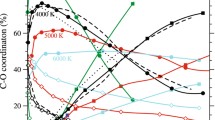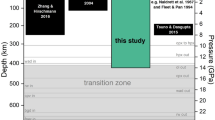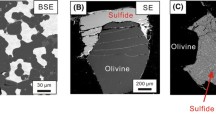Abstract
We present high-pressure experiments from 0.8 to 7.95 GPa to determine the effect of carbon on the solidus of mantle monosulfide. The graphite-saturated solidus of monosulfide (Fe0.69Ni0.23Cu0.01S1.00) is described by a Simon and Glatzel (Z Anorg Allg Chem 178:309–316, 1929) equation T (°C) = 969.0[P (GPa)/5.92 + 1]0.39 (1 ≤ P ≤ 8) and is ~80 ± 25 °C below the melting temperature found for carbon-free conditions. A series of comparison experiments using different capsule configurations and preparations document that the observed solidus-lowering is owing to graphite saturation and not an artifact of different capsules or hydrogen contamination. Concentrations of carbon in quenched graphite-saturated monosulfide melt measured by electron microprobe are 0.1–0.3 wt% in monosulfide melt and below the detection limit (<0.2 wt%) in crystalline monosulfide solid solution. Although there is only a small amount of carbon dissolved in monosulfide melts, the substantial effect on monosulfide solidus temperature means that the carbon-saturated monosulfide (Fe0.69Ni0.23Cu0.01S1.00) solidus intersects continental mantle geotherms inferred from diamond inclusion geobarometry at 6–7 GPa (~200 km), whereas carbon-free monosulfide (Fe0.69Ni0.23Cu0.01S1.00) solidus does not. The composition investigated (Fe0.69Ni0.23Cu0.01S1.00) has a comparatively low metal/sulfur (M/S) ratio and low Ni/(Fe + Ni), but sulfides with higher (M/S) and with greater Ni/(Fe + Ni) should melt at lower temperatures and these should have a broader melt stability field in the diamond formation environment and in the continental lithosphere. Low carbon solubility in monosulfide melt excludes the possibility that diamonds are crystallized from sulfide melt. Although monosulfide melt can store no more than 2 ppm C in a bulk mantle with 225 ppm S, melts with higher M/S could be a primary host of carbon in the deeper part of the upper mantle. For example, the storage capacity of C in sulfide melts in the deep upper mantle (~400 km) for a depleted mantle domain (MORB source, 120 ± 30 ppm S) is estimated to be \(57 \pm_{30}^{63}\) ppm, and so all the C could be in a sulfide melt. In an enriched (OIB source, 225 ± 25 ppm S) mantle domain, the C stored in sulfide melt in the deep upper mantle is estimated to be \(86 \pm_{44}^{92}\) ppm, which would amount to about half the available carbon.








Similar content being viewed by others
References
Anand M, Taylor LA, Misra KC, Carlson WD, Sobolev NV (2004) Nature of diamonds in Yakutian eclogites: views from eclogite tomography and mineral inclusions in diamonds. Lithos 77:333–348
Aulbach S, Griffin WL, Pearson NJ, O’Reilly SY, Kivi K, Doyle BJ (2009) Mantle formation and evolution, Slave Craton: constraints from HSE abundances and Re–Os isotope systematics of sulfide inclusions in mantle xenocrysts. Chem Geol 208:61–88
Ballhaus C, Bockrath C, Wohlgemuth-Ueberwasser C, Laurenz V, Berndt J (2006) Fractionation of the noble metals by physical processes. Contrib Mineral Petrol 152:667–684
Bockrath C, Ballhaus C, Holzheid A (2004) Fractionation of the platinum group elements during mantle melting. Science 305:1951–1954
Brett R, Bell PM (1969) Melting relations in the Fe-rich portion of the system Fe–FeS at 30 kb pressure. Earth Planet Sci Lett 6:479–482
Bulanova GP (1995) The formation of diamond. J Geochem Explor 53:1–23
Chabot NL, Campbell AJ, Jones JH, Humayun M, Vern Lauer H (2006) The influence of carbon on trace element partitioning behavior. Geochim Cosmochim Acta 70:1322–1335
Dasgupta R, Walker D (2008) Carbon solubility in core melts in a shallow magma ocean environment and distribution of carbon between the Earth’s core and the mantle. Geochim Cosmochim Acta 72:4627–4641
Dasgupta R, Buono A, Whelan G, Walker D (2009) High-pressure melting relations in Fe–C–S systems: implications for formation, evolution, and structure of metallic cores in planetary bodies. Geochim Cosmochim Acta 73:6678–6691
Day HW (2012) A revised diamond-graphite transition curve. Am Mineral 97:52–62
Deng L, Fei Y, Liu X, Gong Z, Shahar A (2013) Effect of carbon, sulfur and silicon on iron melting at high pressure: implications for composition and evolution of the planetary terrestrial cores. Geochim Cosmochim Acta 114:220–233
Fei Y, Bertka CM, Finger LW (1997) High-pressure iron–sulfur compound, Fe3S2, and melting relations in the Fe–FeS system. Science 275:1621–1623
Frost DJ, McCammon CA (2008) The redox state of Earth’s mantle. Annu Rev Earth Planet Sci 36:389–420
Gunn SC, Luth RW (2006) Carbonate reduction by Fe–S–O melts at high pressure and high temperature. Am Mineral 91:1110–1116
Gurney JJ, Harris JW, Richard RS (1979) Silicate and oxide inclusions in diamonds from the Finsch kimberlite pipe. In: Boyd FR, Meyer HOA (eds) Proceedings of the 2nd International Kimberlite Conference, AGU, pp 1–15
Haggerty SE (1986) Diamond genesis in a multiply-constrained model. Nature 320:34–37
Hansen M, Anderko K (1958) Constitution of the binary alloys, 2nd edn. McGraw-Hill Book Co., New York 1305 pp
Hart SR, Gaetani GA (2006) Mantle Pb paradoxes: the sulfide solution. Contrib Mineral Petrol 152:295–308
Hasterok D, Chapman DS (2011) Heat production and geotherms for the continental lithosphere. Earth Planet Sci Lett 307:59–70
Helffrich G, Kendall M, Hammond JOS, Carroll MR (2011) Sulfide melts and long-term low seismic wavespeeds in lithospheric and asthenospheric mantle. Geophys Res Lett 38:11301–11305
Hirayama Y, Fujii T, Kurita K (1993) The melting relation of the system, iron and carbon at high pressure and its bearing on the early stage of the Earth. Geophys Res Lett 20:2095–2098
Hirschmann MM (2000) Mantle solidus: experimental constraints and the effects of peridotite composition. Geochem Geophys Geosyst 1:2000GC000070
Hirschmann MM, Dasgupta R (2009) The H/C ratios of Earth’s near-surface and deep reservoirs, and consequences for deep Earth volatile cycles. Chem Geol 262:4–16
Hsieh KC, Schmid R, Chang YA (1987) The Fe–Ni–S system II. A thermodynamic model for the ternary monosulfide phase with the nickel arsenide structure. High Temp Sci 23:39–52
Huang S, Lee CT, Yin QZ (2014) Missing lead and high 3He/4He in ancient sulfides associated with continental crust formation. Nat Sci Rep 4:5314
Kargel JS, Kirk RL, Fegley B, Treiman AH (1994) Carbonate-sulfate volcanism on Venus? Icarus 112:219–252
Katsura T, Yoneda A, Yamazaki D, Yoshino T, Ito E (2010) Adiabatic temperature profile in the mantle. Phys Earth Planet Inter 183:212–218
Klein-BenDavid O, Izraeli ES, Hauri E, Navon O (2004) Mantle fluid evolution—a tale of one diamond. Lithos 77:243–253
Lorand JP, Alard O (2001) Platinum-group element abundances in the upper mantle: new constraints from in situ and whole-rock analyses of Massif Central xenoliths (France). Geochim Cosmochim Acta 65:2789–2806
Lorand JP, Alard O, Godard M (2009) Platinum-group element signature of the primitive mantle rejuvenated by melt-rock reactions: evidence from Sumail peridotites (Oman Ophiolite). Terra Nova 21:35–40
Lorand JP, Luguet A, Alard O (2013) Platinum-group element systematics and petrogenetic processing of the continental upper mantle: a review. Lithos 164–167:2–21
McDonough WF, Sun SS (1995) The composition of the Earth. Chem Geol 120:223–253
Mirwald PW, Kennedy GC (1979) The melting curve of gold, silver, and copper to 60 Kbar pressure: a reinvestigation. J Geophys Res 84:6750–6756
Misra KC, Anand M, Taylor LA, Sobolev NV (2004) Multi-stage metasomatism of diamondiferous eclogite xenoliths from the Udachnaya kimberlite pipe, Yakutia, Siberia. Contrib Mineral Pet 146:696–714
O’Neill HC, Wall VC (1987) The olivine-orthopyroxene-spinel oxygen geobarometer, the nickel-precipitation-curve, and the oxygen fugacity of the Earth’s upper mantle. J Pet 28:1169–1191
Okamoto H, Massalski TB (1990) In: Massalski TB (ed) Au–C (Gold-Carbon), binary alloy phase diagrams, 2nd edn, vol 1, pp 346–348
Pal’yanov YN, Borzdov YM, Bataleva YV, Sokol AG, Palyanova GA, Kupriyanov IN (2007) Sulfide melts–graphite interaction at HPHT conditions: implications for diamond genesis. Earth Planet Sci Lett 250:269–280
Panina LI, Motorina IV (2008) Liquid immiscibility in deep-seated magmas and the generation of carbonatite melts. Geochem Int 46:448–464
Pearson DG, Wittig N (2014) The formation and evolution of cratonic mantle lithosphere: evidence from mantle xenoliths. In: Holland HD, Turekian KK (eds) Treatise on geochemistry, 2nd edn. Elsevier, Oxford, pp 255–292
Pearson DG, Shirey SB, Harris JW, Carlson RW (1998) Sulphide inclusions in diamonds from the Koffiefontein kimberlite, S Africa: constraints on diamond ages and mantle Re–Os systematics. Earth Planet Sci Lett 160:311–326
Richardson SH, Shirey SB, Harris JW, Carlson RW (2001) Archaean subduction recorded by Re–Os isotopes in eclogitic sulfide inclusions in Kimberley diamonds. Earth Planet Sci Lett 191:257–266
Rohrbach A, Ballhaus C, Gola-Schindler U, Ulmer P, Kamnetsky VS, Kuzmin DV (2007) Metal saturation in the upper mantle. Nature 449:456–460
Rohrbach A, Ghosh S, Schmidt MW, Wijbrans C, Klemme S (2014) The stability of Fe–Ni carbides in the Earth’s mantle: evidence for a low Fe–Ni–C melt fraction in the deep mantle. Earth Planet Sci Lett 388:211–221
Rosenthal A, Hauri EH, Hirschmann MM (2015) Experimental determination of C, F, and H partitioning between mantle minerals and carbonated basalt, CO2/Ba and CO2/Nb systematics of partial melting, and the CO2 contents of basaltic source regions. Earth Planet Sci Lett 412:77–87
Ryzhenko B, Kennedy GC (1973) The effect of pressure on the eutectic in the system Fe–FeS. Am J Sci 273:803–810
Saal AE, Hauri EH, Langmuir CH, Perfit MR (2002) Vapour undersaturation in primitive mid-ocean-ridge basalt and the volatile content of Earth’s upper mantle. Nature 419:451–455
Sakamaki K, Takahashi E, Nakajima Y, Nishihara Y, Funakoshi K, Suzuki T, Fukai Y (2009) Melting phase relation of FeHx up to 20 GPa: implication for the temperature of the Earth’s core. Phys Earth Planet Int 174:192–201
Salters VM, Stracke A (2004) Composition of the depleted mantle. Geochem Geophys Geosyst 5:Q05004
Shirey SB, Cartigny P, Frost DJ, Keshav S, Paolo Nimis FN, Pearson DG, Sobolev NV, Walter MJ (2013) Diamonds and the geology of mantle carbon. Rev Min Geochem 75:355–421
Simon F, Glatzel G (1929) Bemerkungen zur Schmelzdruckkurve. Z Anorg Allg Chem 178:309–316
Spetsius ZV, Belousova EA, Griffin WL, O’Reilly SY, Pearson NJ (2002) Archean sulfide inclusions in Paleozoic zircon megacrysts from the Mir kimberlite, Yakutia: implications for the dating of diamonds. Earth Planet Sci Lett 199:111–126
Stachel T, Harris JW (2008) The origin of cratonic diamonds—constraints from mineral inclusions. Ore Geol Rev 34:5–32
Taylor LA, Liu Y (2009) Sulfide inclusions in diamonds: not monosulfide solid solution. Russ Geol Geophys 50:1201–1211
Tsuno K, Dasgupta R (2015) Fe–Ni–Cu–C–S phase relations at high pressures and temperatures—the role of sulfur in carbon storage and diamond stability at mid- to deep-upper mantle. Earth Planet Sci Lett 412:132–142
Tsymbulov LB, Tsemekhman LS (2001) Solubility of carbon in sulfide melts of the system Fe–Ni–S. Rus J Appl Chem 74:925–929
Waldner P, Pelton A (2004) Critical thermodynamic assessment and modeling of the Fe–Ni–S system. Metall Mater Trans B 35B:897–907
Wang Z, Becker H (2013) Ratios of S, Se and Te in the silicate Earth require a volatile-rich late veneer. Nature 499:328–332
Wang C, Hirama J, Nagasaka T, Ban-Ya S (1991) Phase equilibria of liquid Fe–S–C ternary system. ISIJ Int 31:1292–1299
Westerlund KJ, Shirey SB, Richardson SH, Carlson RW, Gurney JJ, Harris JW (2006) A subduction wedge origin from Paleozrchaean peridotitic diamonds and harzburgites from the Panda kimberlite, Slave craton: evidence from Re–Os isotope systematics. Contrib Mineral Petrol 152:275–294
Wood B (1993) Carbon in the core. Earth Planet Sci Lett 117:593–607
Zhang C, Duan ZH (2009) A model for C–O–H fluid in the Earth’s mantle. Geochim Cosmochim Acta 73:2089–2102
Zhang Z, Hirschmann MM (2016) Experimental constraints on mantle sulfide melting up to 8 GPa. Am Mineral (in press)
Acknowledgments
We thank the two anonymous reviewers for their constructive comments. We appreciate the aid and advice of Anthony Withers and Jed Mosenfelder in the experimental petrology laboratory and Anette von der Handt in the electron microprobe laboratory. We are also grateful for the support of NSF Grants EAR1119295 and EAR1426772 as well as support for a summer internship to Nathan Lentsch through the NSF REU program EAR1062775.
Author information
Authors and Affiliations
Corresponding author
Additional information
Communicated by Timothy L. Grove.
Electronic supplementary material
Below is the link to the electronic supplementary material.
Rights and permissions
About this article
Cite this article
Zhang, Z., Lentsch, N. & Hirschmann, M.M. Carbon-saturated monosulfide melting in the shallow mantle: solubility and effect on solidus. Contrib Mineral Petrol 170, 47 (2015). https://doi.org/10.1007/s00410-015-1202-z
Received:
Accepted:
Published:
DOI: https://doi.org/10.1007/s00410-015-1202-z




